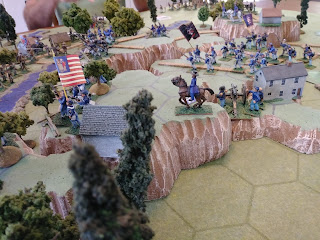Maurice
Well, here it is, nearly the end of June, and I almost missed writing a post. I don't want to let down my dear readers, so I wanted to share what's been going on in my gaming life. Most of my hobby activity this month has been painting (more about that later), but just this past week, my good friend Charles came over to my home to play Maurice, by Sam Mustafa. We played about 3 hours on Tuesday night, but hadn't played all the way through the second deck. So we agreed to resume the game on Thursday night. How it took us six hours to play a game rated to take only 2-3 hours I don't know, but it was the most fun I have had playing a wargame in ages, and confirms my feeling that Maurice belongs firmly in my top 3 favorite wargames of all time.
We made a lot of errors while playing, most notably my charges on his cavalry at the end of the game. I took away his last morale point on the last turn I could play, as we had no more cards left after that. It was an epic victory for me, achieved by forgetting the rule that infantry cannot charge cavalry, unless the target unit is in a town. But it was still great fun, for my opponent as well me! I didn't get any pictures of the game in progress, but my recorded the second session, which I will link to as soon as it is posted.
American Civil War, home brew rules
On Sunday afternoon, I was graciously invited to join another friend, Glenn, at his man-cave gaming shed, to play Glenn's home brew version of Battle Cry along with Charles and Nick.
Glenn has been working on this game for awhile now, and was testing the rules with a historical scenario, Gaines' Mill. This was one of the Seven Days' battles that concluded George McClellan's peninsular campaign in 1862.
If the dice in the second picture look familiar, they are straight from Battle Cry/Command and Colors series of games. What was different about this variant were the cards used to activate units in the game.
Before the game, I was concerned that in a multiplayer game, I would spend a lot of time waiting for my turn. Indeed, that is exactly what happened the one time I played in a 6 player epic scale C&C Ancients game. Instead, this version had each player on a side draw 5 cards, and each round, each player would secretly select one card from his hand.
The order of activation is determined by the number next to the clock symbol at the bottom center of each card, with more aggressive actions taking place later in the round (higher numbers). The occasions where both sides have the same activation number were resolved by taking turns exchanging the initiative.
At the end of five rounds (when all the players' cards were exhausted), all the players drew five new cards, and a new turn began. This format worked extremely well for a miniatures game with more than one player per side. Indeed, it could easily be scaled up as large as you wished, so long as your table space and miniatures collection permits.
While the rules worked extremely well, our host determined that the Union army should start with fewer troops on the table at start, to give the Confederate army the opportunity to attack sooner than historically, and make the scenario a closer contest. The number of CSA units destroyed was overwhelmingly higher than the number of Union units lost.
That's all the miniatures gaming I for this month of June. In addition to miniatures, my wife and I have played at least one game of Catan with our next door neighbors on my birthday. But euro games are not the focus of this blog, so I won't dwell on that.
If the dice in the second picture look familiar, they are straight from Battle Cry/Command and Colors series of games. What was different about this variant were the cards used to activate units in the game.
Before the game, I was concerned that in a multiplayer game, I would spend a lot of time waiting for my turn. Indeed, that is exactly what happened the one time I played in a 6 player epic scale C&C Ancients game. Instead, this version had each player on a side draw 5 cards, and each round, each player would secretly select one card from his hand.
The order of activation is determined by the number next to the clock symbol at the bottom center of each card, with more aggressive actions taking place later in the round (higher numbers). The occasions where both sides have the same activation number were resolved by taking turns exchanging the initiative.
At the end of five rounds (when all the players' cards were exhausted), all the players drew five new cards, and a new turn began. This format worked extremely well for a miniatures game with more than one player per side. Indeed, it could easily be scaled up as large as you wished, so long as your table space and miniatures collection permits.
While the rules worked extremely well, our host determined that the Union army should start with fewer troops on the table at start, to give the Confederate army the opportunity to attack sooner than historically, and make the scenario a closer contest. The number of CSA units destroyed was overwhelmingly higher than the number of Union units lost.
That's all the miniatures gaming I for this month of June. In addition to miniatures, my wife and I have played at least one game of Catan with our next door neighbors on my birthday. But euro games are not the focus of this blog, so I won't dwell on that.



